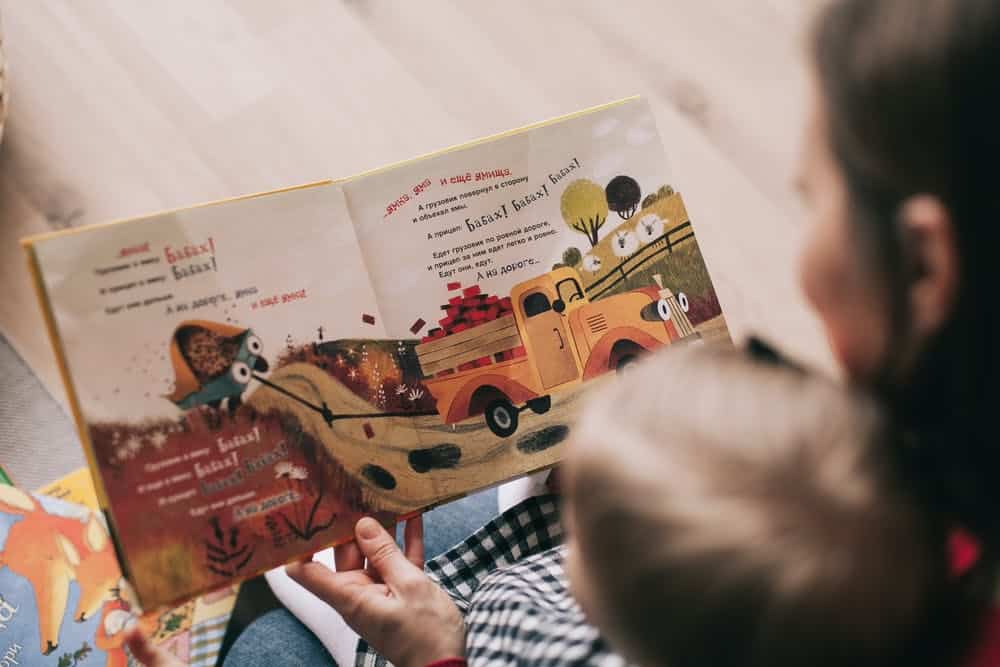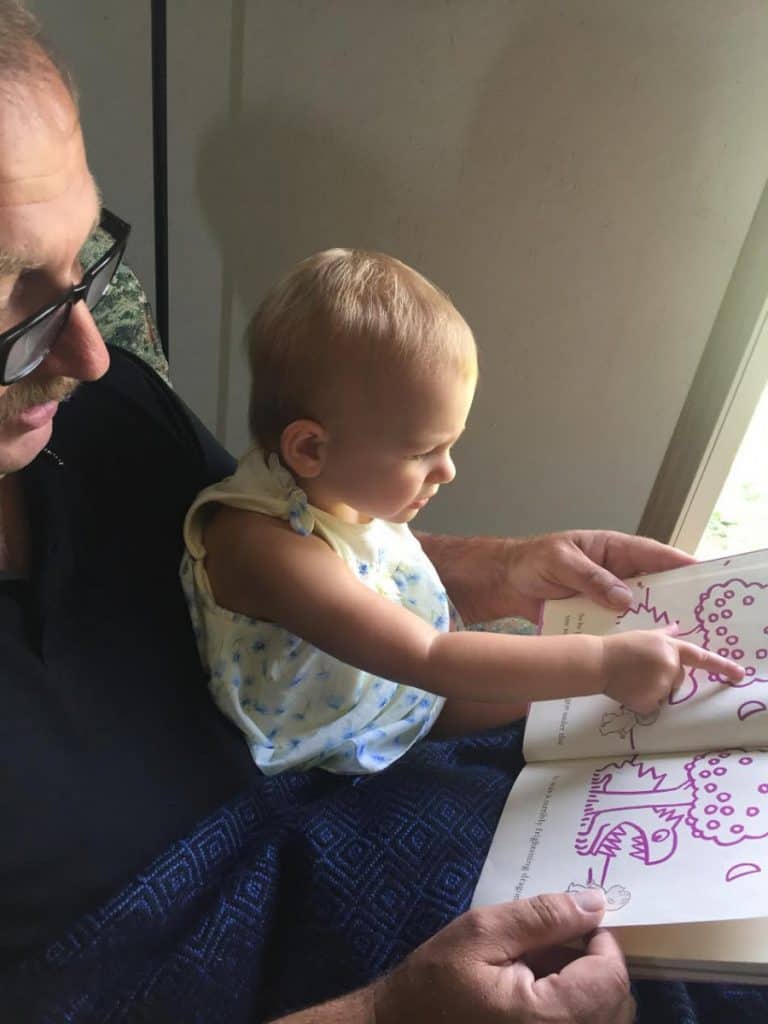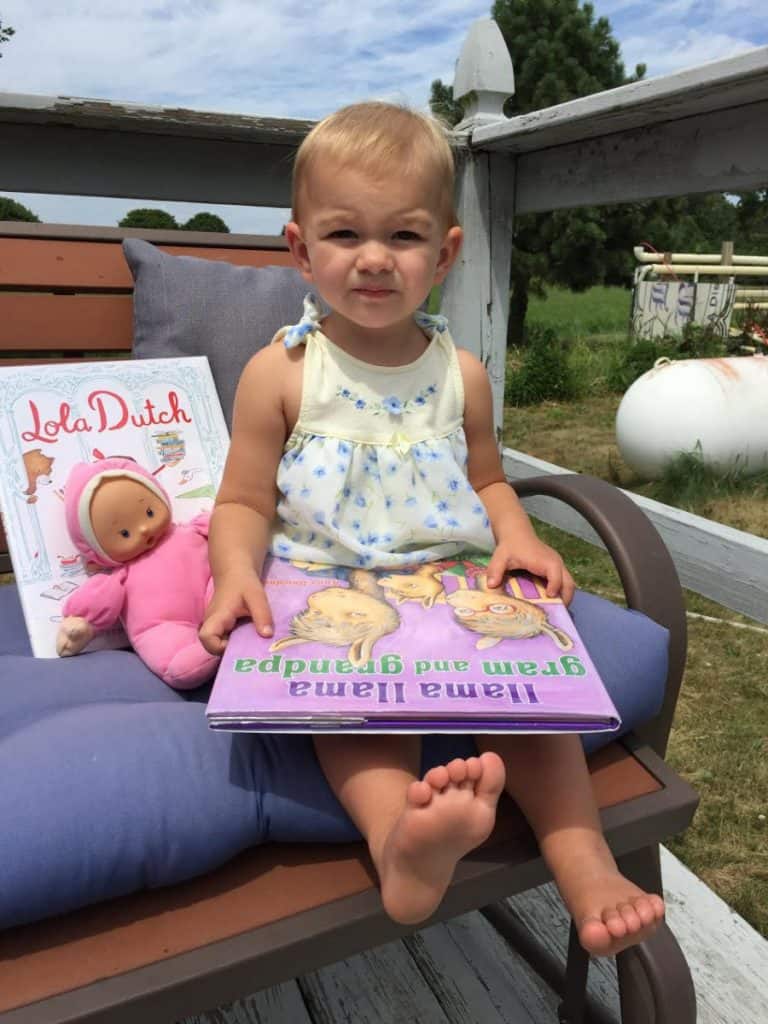
If you’re looking for practical ways to have a reading family, here’s ideas that worked for our family when our four kids were growing up.
- Add reading to the chore chart
- Capitalize on trips as prime reading time
- Do the work to surround your kids with great books
- Stop the Summer Slide by taking regular library trips
- Prioritize parental enjoyment of Read Aloud sessions
- Discuss books like Book Club, not like school assignments
- Fit reading into daily rhythms
- Take advantage of weekends, sick days and vacations for more reading.
- Go the extra mile to help them with reading skills
If you want to build a reading family, but feel like you’re swimming upstream, I understand. But I want to encourage you that it is possible. Even with all the temptations of screens and all the busyness of work and activities. Even with short attention spans and distracted living you can do it.
It will take intentionality. Maybe some false starts. Maybe some hit and miss. Hang in there. I believe this is an achievable goal.
I had some advantages on this front. I was raised in a reading family. It was in my DNA. My grandmother was a librarian, my mother had a masters in education. Reading was my favorite hobby and before I had kids I looked forward to reading to them. My kids got books for gifts. We visited the library regularly. Reading aloud was part of our rhythms at nap time, at bedtime and on trips.
But no matter where you start, you can do this! You can have a reading family. And, I promise, the rewards are worth all the effort.
Create an environment conducive to reading
First, you need places to read. Book nooks or window seats are great. But couches, rocking chairs, bean bags, recliners or beds can work, too. Comfortable seating and good lighting are key to creating the best environment.
There’s also a need for book storage. Bookshelves are the obvious solution, but baskets, desks and tables can serve and toy bins works for baby’s books.
Surrounding yourself with great books means you need a place to keep them. Make it a beautiful place for your sanity and mental health.

Surround your kids with great books
The selection of easily accessible books is critical. It makes a huge difference if great books are at your fingertips or not.
Separating the wheat from the chaff will take some work. Soldier on. It’s worth it.
Wonder and The Penderwicks are great places to start for school aged kids.
Buy Books and Borrow Books
Libraries are incredible places. Free books on loan. What could be better? For the voracious reader and for the vast array of choices, you can’t beat the library.
But, there is something about the books you own. You know, the ones with your name in them. The ones that were a gift from someone special. The ones that you take with you when you leave home. You know. Those books.
I’ve found in recent years that our library doesn’t have a very wide selection of board books. I’ve also noticed that Amazon sells a lot of them. Board books are good books to buy because babies eat them up. Literally.
They are also fairly reasonably priced on Amazon or Bookshop or wherever books are sold.
There’s an emotional attachment to great books and great stories in your childhood. Your world view is being formed, your beliefs and assumptions are developing. What you’re absorbing during your first 18 years is so important.
Just like Kathleen Kelly says in You’ve Got Mail, the books you read as a child impacts you in ways that no other reading does for the rest of your life. It’s worth investing some time and money. It’s worth searching for the best resources so that you’re spending money on the best books.
Just do it.
Give books for Christmas, birthdays and special occasions
Some kids seem to have everything.
It’s hard to know what to get them. Toys and clothes are great and necessary. So are coupons for experiences. But you can’t go wrong with books.
Find a good list of recommendations. When you find a list you can trust, you’ve found gold.
Two of my favorite are Read Aloud Revival’s Book List and Sonlight Homeschool Curriculum Book List.
I also have a list of recommendations for babies and one for toddlers.
Make time in the schedule for free reading
It’s tempting to overload our kids’ schedules. But how many activities do they need? Some of it might depend on the child, how much socializing versus down time they need. Don’t forget your own needs and the health of the family in general. If you’re running ragged and out of sorts keeping up with the kids’ activities, dial it back. Your life matters, too.
If older kids have a lot of games, practices and rehearsals that younger kids are dragged to, redeem the time. Pack some books, water bottles and snacks. When there’s a break in the action or you’re waiting for your athlete to get debriefed or change out of uniform, sneak in a book or two with the younger ones.
Let them see you reading
This one might seem obvious, and maybe you’re already doing it.
Or maybe life has gotten so overwhelming that you’ve lost your passion for reading or never developed in in the first place.
The other possibility is that you only read when the kids are asleep. Steven Covey, the author of 7 Habits of Highly Effective People, was a voracious reader, but did all of his reading when the kids were in bed. When he heard a child say they never saw him read, he changed his routine to make his habit more visible to his kids.
Read aloud at nap time and bedtime
There’s something sweet about a clean, damp-haired child in footie pajamas. Add a fuzzy blanket and a great story book and the stage is set for some serious snuggling.
Bedtime stories can be geared toward multiple ages at once. All the greatest books appeal to a range of ages.
Different story times for different ages and interests works, too.
If bedtime at your house is chaotic, give yourself permission to start small. Don’t get discouraged if it’s hit or miss. Keep trying. Establishing new habits will take time and persistence.

Prioritize parental enjoyment of family reading times
One of the critical ingredients is pleasing both audiences. Both kids and adults have to be enjoying the experience. The adult has veto power. That means that books that have been read so many times they’ve lost their attraction can mysteriously disappear. Introduce some new ones until some new favorites develop.
Let the kids pick their favorites. Curate the pool they choose from. That’s how you place your vote. They pick from the selection you’ve curated. That’s how they vote.
This is impossible to overemphasize. If you aren’t enjoying it, you won’t be able to manufacture enthusiasm for reading time.
Chosen books have to fall in that sweet spot, that overlapping area of the Venn diagram where the adults enjoy them and the kids enjoy them.
It might take a little digging. It might take some hit or miss. Don’t give up. There’s some real treasures out there.
Visit places made famous by great literature— Prince Edward Island, the houses of Gene Straton-Porter, the places where Laura Ingalls Wilder lived.
Use vacation, sick days and weekends as time for extra reading
Normal weekday schedules can be really crazy, especially if you have kids with lots of activities.
It might be possible to squeeze in short reading sessions on some days, but maybe not on others.
Take advantage of vacation days, sick days and weekends to get in longer sessions of read aloud time or free reading.
If you’re ambitious, visit places made famous by great literature— Prince Edward Island, the houses of Gene Straton-Porter, the places where Laura Ingalls Wilder lived.
Add reading to chore charts
When our kids were growing up, I was a huge fan of summer chore charts.
I loved charts.
I still do.
So, besides the normal chores of dishes, putting away clean clothes, taking out trash and getting some exercise, our kids were expected to read books.
I picked the books I wanted them to read.
There were books in my life that impacted me. I wanted them to impact my kids in the same way.
Joni, The Hiding Place, Do Hard Things.
My daughter is amazed now to think about all the work she put in during the summer just to earn a $5 rabbit as a prize.
They either didn’t know or didn’t think about the fact that not many other kids were required to read specific books.
So, they did the charts and they read the books and they won the prize rabbits.
We also had family night every week.
Sometimes we played games, sometimes we played outside but most weeks we watched movies together. I remember times when I was so tired that it was hard to play games with the kids. It was hard to concentrate. Hard to stay awake. I fell asleep sometimes with the movies, too.
Now it’s time to do things with the grandkids.
Don’t be afraid to assign specific books
This especially applies to 10-14 year olds
Looking back, I’m amazed that my kids read the books I picked out for them. Not always, of course. Sometimes they gave me push back. But, a lot of times they did.
I remember hearing Kathy Peel speak in Dallas on a Saturday about her teenage son being at home working through his assigned list of tasks that included a specific book to read. I thought to myself, “Wow. You can do that? I am definitely stealing that.”
My kids were little then, and easier to influence. But it planted a seed that I definitely nurtured and cultivated.
Watch movie adaptions of great books
Watching movie adaptations of great books is a good way to build interest in reading.
You can watch them before you read the book or afterwards.
The Jungle Book. It’s easy to forget that the movie started out as a great piece of literature.
Chitty Chitty Bang Bang.
Mary Poppins.
The Wizard of Oz
The Chronicles of Narnia.
Aladdin.
All the Cinderella stories. Ever After is one of my favorite.
Lots of great movies started out as great children’s literature.
There’s some great ones for older kids and teens as well.
The Importance of Being Earnest.
Pride and Prejudice. (I’m a fan of the Keira Knightly version.)
The Lord of the Rings.

Read aloud on road trips
We traveled thousands of miles with our kids on family road trips. We had a gray fifteen passenger van that we packed to the gills with our four kids, friends, luggage and sometimes the dog.
Usually the pressure was on to make time and cover as many miles possible in the shortest amount of time.
We were blessed to have not too much carsicknesses and not too much whining and complaining. Our kids were good travelers.
I love a long stretch of highway. The rhythm of the tires on the road. The quietness of the night time sky full of stars and an empty road ahead.
Lots of memories, lots of stories from those traveling days.
But the best memories for me were reading aloud to the kids on those trips.
Cheaper By the Dozen. The Chronicles of Narnia. The Great Brain. The Hobbit.
Books we all loved.
Listen and watch on road trips
I realize that road tripping today is different than when my kids were little. The good news is there’s more options than ever to build a reading family on road trips.
Playing songs over the car speakers also builds vocabulary and helps family bonding. Road trips are a good time to squeeze in those movie editions of great literature. Getting kids hooked on the story will open the door for reading the book. Or, you could save the movie edition for after the book is finished.
Road trips are also a great way to listen to audiobooks as a family. There’s some books that have a wide range of appeal, starting with 4 or 5 year olds up through adults. Pick some of these books to create family memories and build a family culture around books.
Finally, if everyone needs some peace and quiet, kids can pull their own books or audiobooks and earbuds out of their backpacks. The good news is, when the book bug bites your kids, they’ll want to pack their own books to bring along.
Practice new reading skills by reading aloud
Read Aloud Revival hosts a 31 day reading challenge every January where kids are encouraged to read aloud.
They can read to siblings, parents, grandparents, pets or even stuffed animals. It’s a very doable challenge with leeway for missed days but it still gives structure and something to reach for.
Find out all about the challenge at Read Aloud Revival.
Or watch this video.
Get them help if they’re having trouble learning to read
Most of the time all a beginning reader needs is help learning new words, lots of practice and lots of encouragement.
But, occasionally, some extra expertise is needed for a struggling reader.
One of our kids found reading unusually challenging. We started a journey, beginning with the eye doctor, to pinpoint the difficulty and ways to resolve it. Over a period of five years we were able to uncover his learning challenge and implement an unconventional program to equip him for his education.
It’s worth the cost to help your kids jump their hurdles.
Be aware of what your kids are reading
Keep an eye on what your kids are reading. Developing their own taste for reading and choosing their own books is important. You don’t want to squelch that. But you also need to have your antenna up when your kids stumble across books in opposition to your values.
Read reviews of books you haven’t read yourself
Trying to stay ahead of a voracious reader (or 2 or 3) can be an exercise in futility. Reading reviews is a good short cut to previewing the entire book. Look for reviews that will explore content.
Kids in mind has a limited amount of reviewed books. There are some other sites that do reviews of kids’ books, like Focus on the Family’s Plugged In.
Have you ever wondered why books don’t have ratings like movies? I was curious about that and was surprised what I found out after doing some digging. There’s some opposition to rating books. The reason the movie rating system was developed was a response to a Supreme Court ruling that movies were not protected under free speech and freedom of the press laws. That ruling was overturned 37 years later, but the movie rating system had already been established. It continues to develop and serves a purpose today.
Read all the reasons why books don’t have ratings like movies here.
Don’t micromanage what they’re reading
In between assigning specific books to read and giving them free range reading is the middle ground of being aware of what they’re reading, making suggestions and having great books accessible in the house for when the mood strikes.
When my son was assigned a book report that had to be a biography, I went to the library and checked out five or six good options and brought them home so he could choose.
When he needed to read a classic, I did the same thing.
Of course, be aware that during certain seasons of the parent-teen relationship, anything a parent suggests is going to be the exact opposite of what the teen chooses.
These are the laws of human nature. Every emerging adult needs to assert their independence. Sometimes that means vetoing suggestions. Take it with a grain of salt.
Make Reading the Reward
When I was homeschooling, read aloud was the favorite part of the day, for my student and for me. We saved it as the reward for getting everything else on the list done for the day.
It helped keep us motivated. It helped keep us on track. It also helped keep our list of daily tasks manageable.
One year I had a great plan to read Swiss Family Robinson, a family about four boys on a deserted island and then Little Women, a story about four girls growing up in poverty and then assigning a “compare and contrast” essay on the two books.
The first book, Swiss Family Robinson, went great.
We both loved it.
Little Women, not so much. My seventh grade son rebelled and let me know in no uncertain terms that he didn’t like my choice. I caved. The essay was never written.
I still think it was a great idea though.
Find series for kids that they love
Once kids start reading on their own, a great way to throw fuel on the fire is to help them find series that they love.
Once they get excited about a series, they can blow through it quickly. They know what they’re going to read next. They won’t spend any time searching for their next read. They’ll just spend that time reading.
Hardy Boys and Nancy Drew and Cherry Ames were series that I loved as a kid as well as Encyclopedia Brown.
Little House on the Prairie is a great read aloud series or one to read on your own.
The Penderwicks and Michael Vey books are more recently published series that kids love.
Discuss books like Book Club
Sarah Mackenzie of Read Aloud Revival suggests creating a Book Club culture in your home.
Discussions about books can be open ended questions like “Which character in the book was most courageous? Or cowardly or wicked or noble?” and “What surprised you in this book?”
You don’t have to make a literary analysis. You don’t have to look up vocabulary words. You don’t have to study it.
You can just read it for the pure enjoyment of it.
Then, instead of answering questions about it to prove comprehension and critical thinking skills, you can just discuss it the same way you would discuss it with a Book Club. The things you loved and the emotions it surfaced as well as beliefs that were challenged or reinforced.
Sarah also advocates making the book discussion an event, with food and drinks that might fit a theme or might not. The point is to have a good time and celebrate the enjoyment of a book, not turn it into a textbook to be studied.
Encourage them to do art inspired by books
There’s a lot of different ways to go here. Not only can you draw pictures, paint pictures and make little books, you can also cook up recipes inspired by the the books you’re reading.
Chitty Chitty Bang Bang has a recipe for fudge in the back of the book.
American kids who read The Lion, the Witch and the Wardrobe wonder what Turkish Delight tastes like. I’ve seen some explanations, read some recipes. I think I even tried to make it once. I wasn’t impressed. But, the point is, our curiosity is piqued.
When I read through Farmer Boy, it seemed like all that family did was cook and eat great food. Homemade donuts stands out in my memory. Who am I to argue with literature inspired cooking?

Ask them share with Grandma
Sharing books with Grandma is now easier than ever with Skype and Facetime.
Older kids can talk about what they’re reading.
Babies, toddlers and pre-schoolers can actually read long distance with Grandma if both have a copy of the same book.
Send Once a Month Books
I love reliving every age and stage that kids go through again as a Grandma.
One of the best parts is finding, gifting and reading books to my grandbabies.
Inspired by Dolly Parton’s Imagination Library, I send a book a month to my faraway grandson.
Dolly sends one book a month for a child’s first five years to promote literacy and education. She started in her home county, but the program has grown across her home state and around the United States and to other countries.
The fact is, when books are owned, when they are in the home, when a child is surrounded by books, it makes a difference.
Accessibility matters. Books that don’t need to be returned to the library are books that can be loved in a different way.
